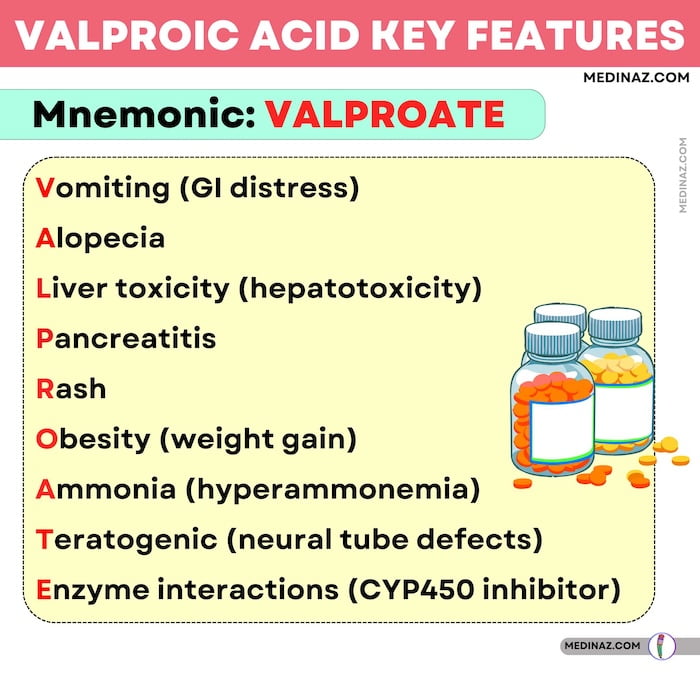Valproic acid is an anticonvulsant and mood-stabilizing drug used primarily in the treatment of epilepsy, bipolar disorder, and for the prevention of migraines.
Chemical Class: Fatty acid derivative.
Mechanism of Action:
- Increases GABA (gamma-aminobutyric acid) levels by inhibiting GABA transaminase.
- Blocks voltage-gated sodium channels.
- Modulates T-type calcium channels.
Indications
Epilepsy:
- Generalized tonic-clonic seizures.
- Absence seizures.
- Myoclonic seizures.
- Complex partial seizures.
Bipolar Disorder:
- Acute mania.
- Maintenance therapy.
Migraine Prophylaxis:
- Prevention of migraine headaches.

Pharmacokinetics
- Absorption: Well absorbed orally.
- Distribution: Highly protein-bound (~90%); crosses the blood-brain barrier.
- Metabolism: Primarily hepatic via glucuronidation and mitochondrial beta-oxidation.
- Excretion: Excreted primarily in urine as metabolites.
Dosage
Epilepsy
- Initial Dose: 10-15 mg/kg/day.
- Dose Adjustment: Increase by 5-10 mg/kg/week until optimal clinical response is achieved.
- Usual Maintenance Dose: 15-60 mg/kg/day, with the maximum recommended dose generally being below 60 mg/kg/day. (ref)
Bipolar Disorder
- Initial Dose: 750 mg/day.
- Maintenance Dose: 20-30 mg/kg/day.
Migraine Prophylaxis
- Initial Dose: 250 mg twice daily.
- Adjustment: The dose may be increased based on clinical response, with a typical range being 500 mg once daily for extended-release formulations
Valproic acid Side Effects
Common:
- GI distress (nausea, vomiting, abdominal pain).
- Tremor.
- Weight gain.
- Hair loss (alopecia).
Serious:
- Hepatotoxicity (black box warning).
- Pancreatitis (black box warning).
- Thrombocytopenia.
- Hyperammonemia (can lead to encephalopathy).
- Teratogenic effects (neural tube defects, black box warning).
- Polycystic ovarian syndrome (PCOS) in females.

Valproic acid Contraindications
- Liver Disease: Risk of hepatotoxicity.
- Pregnancy: High risk of teratogenic effects (especially neural tube defects).
- Urea Cycle Disorders: Risk of hyperammonemia.
- Pancreatitis: History of or active pancreatitis.

Drug Interactions
- Enzyme Inhibitor: Inhibits cytochrome P450 enzymes, leading to increased levels of other drugs metabolized by these enzymes (e.g., phenobarbital, lamotrigine).
- Protein Binding: Can displace other protein-bound drugs, leading to increased free drug levels (e.g., warfarin, phenytoin).
- Combination with Carbamazepine: Decreases valproic acid levels; increases carbamazepine-epoxide levels.
Monitoring
- Liver Function Tests (LFTs): Regular monitoring due to risk of hepatotoxicity.
- Complete Blood Count (CBC): Monitor for thrombocytopenia.
- Ammonia Levels: Monitor in patients with symptoms of encephalopathy.
- Serum Valproic Acid Levels: Therapeutic range is typically 50-100 µg/mL.
Toxicity and Overdose
Symptoms:
- CNS depression (coma, confusion).
- Respiratory depression.
- Hyperammonemia.
- Metabolic acidosis.
Management:
- Supportive care (airway, breathing, circulation).
- Hemodialysis in severe cases.
- L-carnitine for hyperammonemia.
Valproic Acid Mnemonic:
Remember VALPROATE for key features of Valproic Acid:
Vomiting (GI distress).
Alopecia.
Liver toxicity (hepatotoxicity).
Pancreatitis.
Rash.
Obesity (weight gain).
Ammonia (hyperammonemia).
Teratogenic (neural tube defects).
Enzyme interactions (CYP450 inhibitor).

Chart: Monitoring Parameters for Valproic Acid
| Parameter | Monitoring Frequency | Purpose |
| Liver Function Tests (LFTs) | Baseline, then every 6 months | Detect hepatotoxicity |
| Complete Blood Count (CBC) | Baseline, then periodically | Monitor for thrombocytopenia |
| Serum Ammonia Levels | As needed, especially if symptoms of encephalopathy | Detect hyperammonemia |
| Serum Valproic Acid Levels | Periodically, especially if toxicity is suspected | Ensure therapeutic drug levels (50-100 µg/mL) |
Table: Comparison of Valproic Acid with Other Anticonvulsants
| Drug | Mechanism of Action | Indications | Key Side Effects |
| Valproic Acid | Increases GABA, blocks sodium channels | Generalized seizures, Bipolar disorder, Migraine prophylaxis | Hepatotoxicity, Pancreatitis, Teratogenicity |
| Phenytoin | Sodium channel blocker | Focal and generalized tonic-clonic seizures | Gingival hyperplasia, Hirsutism, Ataxia |
| Carbamazepine | Sodium channel blocker | Focal seizures, Trigeminal neuralgia | Agranulocytosis, Hyponatremia, Diplopia |
| Lamotrigine | Sodium channel blocker | Seizures, Bipolar disorder | Rash (Stevens-Johnson syndrome), Dizziness |
| Levetiracetam | Modulates synaptic vesicle protein SV2A | Seizures | Behavioral changes (irritability, aggression), Somnolence |
High-yield points for USMLE, NEET PG, NBDE, NCLEX Exams:
- Broad Spectrum Antiepileptic Drug
- Effective in all types of seizures.
Mechanisms of Action:
- Blockade of use-dependent Na+ channels.
- Increased activity of GABA:
- Stimulates glutamic acid decarboxylase, increasing GABA synthesis.
- Inhibits GABA transaminase, decreasing GABA metabolism.
- Inhibits T-type Ca2+ channels.
- Decreases the release of glutamate in the brain.
Indications:
Drug of choice (DOC) in:
- Generalized tonic-clonic seizures (GTCS).
- Myoclonic, atonic, atypical absence, clonic, and tonic seizures.
Effective in:
- Lennox-Gastaut syndrome.
- Absence seizures.
- Infantile spasms.
- Partial seizures.
Precautions:
- Gradual discontinuation is necessary to avoid withdrawal seizures.
Other Uses:
- Bipolar disorder (especially in patients with rapid cycles, i.e., 4 or more cycles per year).
- Prophylaxis of migraine.
- Alternative to carbamazepine in trigeminal neuralgia.
- Used in tardive dyskinesia.
Enzyme Interaction:
- Potent microsomal enzyme inhibitor.
Adverse Effects:
- Weight gain.
- Alopecia.
- Tremors.
- Carnitine deficiency.
- Irreversible hepatic necrosis (especially in children < 2 years old).
- Acute pancreatitis.
- Hyperammonemia.
- Risk of neural tube defects if used during pregnancy (can be mitigated by folic acid administration).
Check other Medinaz Pharmacology Notes
A Visual Learning Platform





